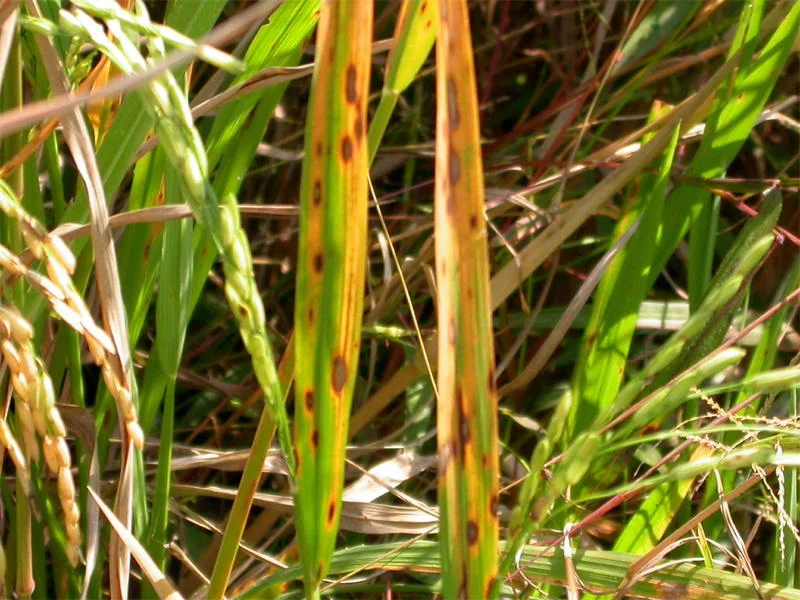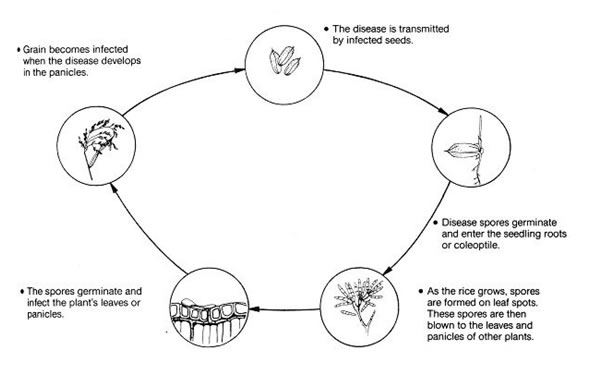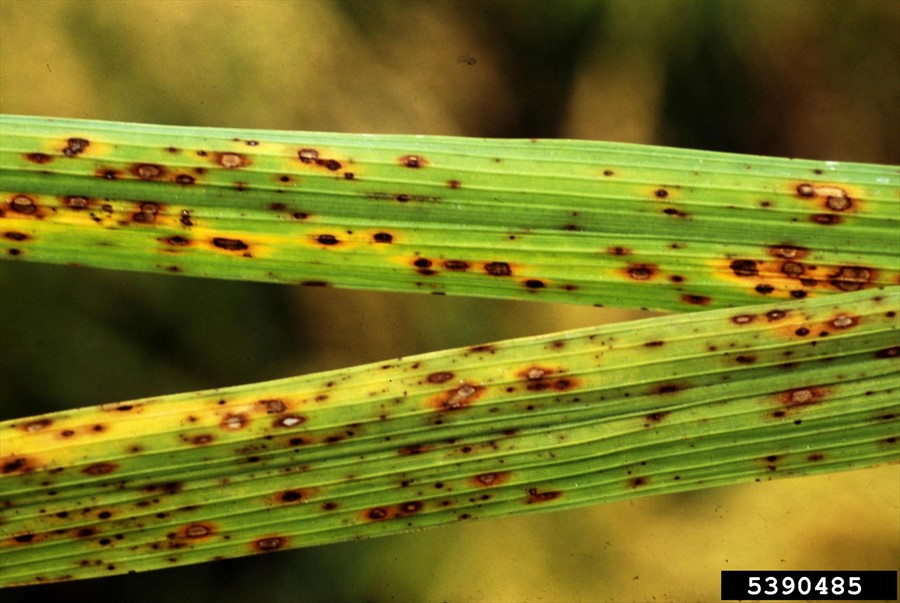| Disease | Rice Brown Spot |
|---|---|
| Hosts | Rice |
| Pathogen | Helminthosporium oryzae —FUNGAL DISEASE |
What Is Brown Spot of Rice?
Brown spot is a fungal disease that can infect both seedlings and mature plants. The disease causes blight on seedlings grown from heavily infected seeds and can cause 10-58% seedling mortality. The disease was considered a major factor in the “Great Bengal Famine” in 1942, resulting in yield losses of 50% to 90% and causing the death of 2 million people.
In Guyana, severe infection can lead to a reduction in yield of up to 45% and moderate infection can result in a 12% reduction. Yield losses in Bengal in 1942 were attributed to continuous temperatures of 20°C-30°C for two months, unusually cloudy weather, and higher-than-normal temperature and rainfall during flowering and grain-filling stages.
Symptoms of Brown Spot of Rice:

1. Seedling Stage:
- The disease can manifest as seedling blight, affecting the crop from the nursery stage to the milk stage in the main field.
- Initially, small brown dots appear, which later develop into cylindrical or oval to circular spots resembling sesame seeds.
- The spots measure between 0.5 to 2.0mm in breadth and can coalesce to form larger patches.
- Infected seedlings may exhibit a brownish scorched appearance, making affected nurseries easily recognizable from a distance.
- In severe cases, the fungus can girdle the coleoptile, causing distortion of the leaves and even stunting or death of the seedlings.
2. Foliar and Glume Disease:
- In mature plants, the disease primarily affects the leaves, appearing as light brown to gray lesions with a reddish-brown margin.
- Lesion length varies from 1mm to 14mm, depending on the cultivar.
- On resistant cultivars, the fungus produces tiny dark specks on the lesions.
- Severe infections can cause lesions to coalesce, leading to the death of large areas of affected leaves.
- The fungus can also infect the glumes and grains, resulting in dark brown or black spots on the glumes.
- Infected seeds may exhibit black or brown spots covered by an olivaceous velvety growth.
- Brown spot infection on seeds can cause failure of germination, seedling mortality, and a reduction in grain quality and weight.
Yield Impact:
- Severe cases of brown spots of rice can cause a significant yield reduction of up to 50%.
It’s important to note that the lesions of brown spots can sometimes be mistaken for rice blast lesions, another common disease in rice plants.
Disease Cycle of Brown Spot of Rice:

Inoculum Source:
The fungus causing Rice Brown Spot disease can survive in various sources:
- Infected seeds: The disease can be transmitted from infected seeds, which act as a primary source of inoculum.
- Volunteer rice: Infected plants from previous seasons can serve as a reservoir for the fungus.
- Rice debris: Residual plant material left in the field after harvest can harbour the pathogen.
- Wild grasses: Certain grass species can host the fungus and contribute to its survival.
Disease Development:
The disease cycle begins with the presence of favourable conditions, including:
- Temperature: The optimal temperature range for disease development is 25-30°C.
- Relative humidity: Disease incidence is favoured by relative humidity levels above 80%.
- Moisture on leaves: Infection requires leaves to be wet for 8-24 hours, providing a suitable environment for the fungus to invade.
Infection:
The fungus primarily infects seedlings and various plant parts, including leaves, leaf sheaths, panicles (including glumes), and seeds. The infection process involves the following steps:
- Seedling stage: Small circular spots appear on the leaf sheaths, girdling and distorting them.
- Tillering stage: Circular to oval spots, ranging up to 10 mm in length, develop on the leaves. These spots darken to a dark brown or purple colour.
- Maturation stage: The spots mature and exhibit light brown to grey centres surrounded by dark brown margins.
- Seed infection: Infected seeds show the characteristic “eye-spot” symptom, with brown spots and light centres. Infected seeds often fail to develop properly.
Spread and Dispersal:
- Short-distance spread: The fungus can disperse over short distances through wind-borne spores.
- Long-distance spread: Infected seeds play a significant role in the long-distance dissemination of the disease.
Survival and Overwintering:
The fungus can survive and overwinter in various ways:
- Infected seeds: The pathogen can persist in infected seeds, carrying the disease to subsequent seasons.
- Volunteer rice: Infected plants that grow as volunteers in the field act as a source of inoculum.
- Rice debris: Residual plant material left in the field provides a potential reservoir for the fungus.
- Wild grasses: Some grass species can host the fungus, contributing to its survival.
Management Strategies for Brown Spot of Rice:
Cultural Methods:
- Use Disease-Free Seeds: To mitigate the spread of the disease, it is essential to start with disease-free seeds. Select seeds from reliable sources and ensure they have undergone proper seed treatment and certification processes.
- Removal of Alternate and Collateral Hosts: Identify and remove any alternate or collateral hosts of the Brown Spot fungus in the vicinity of the rice field. This helps in reducing potential sources of inoculum and preventing the disease from spreading.
- Resistant Varieties: Utilizing resistant rice varieties is the most cost-effective approach for disease control. Choose and cultivate resistant varieties known to exhibit strong resistance against Brown Spot, such as ADT 44, PY 4, CORH 1, CO 44, CAUVERY, BHAVANI, TPS 4, and Dhanu. Consult local agricultural extension services to determine the most suitable resistant varieties for your specific region.
- Optimal Plant Nutrition and Water Management: Providing plants with proper nutrition and preventing water stress are crucial factors in managing Brown Spots. Ensure that rice plants receive adequate and balanced fertilization according to recommended rates. Additionally, optimize water management by maintaining proper irrigation schedules to prevent water stress and promote healthy plant growth.
- Soil Amendment: In soils known to be low in plant-available silicon, it is beneficial to amend the soil with calcium silicate slag before planting. This amendment helps enhance plant resistance to Brown Spots. Adequate irrigation should also be ensured to avoid water stress conditions.
Preventing Method:
IZUMONAS
Contents: Pseudomonas Fluorescens
IZUMONAS is a biological product consisting of plant growth-promoting rhizobacteria (PGPR), which are naturally occurring bacteria found widely in nature. This unique product is designed to enhance plant defence mechanisms and promote healthy growth. IZUMONAS can be used on all types of crops without leaving any residue on the plants.
IZUMIL
Contents:
- Extract of Streptomyces griseus: 30%
- Extract of Streptomyces violaceus: 40%
- Dissolving agents: 30%
IZUMIL is a remarkable biotech research product that has been developed to activate the natural defence mechanism of plants. By using IZUMIL, plants can better protect themselves against fungal pathogens, improve their physiological functions, and develop resistance against various harmful microorganisms. Similar to IZUMONAS, IZUMIL can be safely used on all crops without leaving any residue.
Modes of Use:
- Seed Treatment: Mix 5-10 ml of IZUMONAS and IZUMIL per kilogram of seeds in an adequate amount of water. Submerge the seeds in this solution and allow them to dry in a shaded area before sowing.
- Seedling Treatment: Combine 100 ml of IZUMONAS and IZUMIL per 20 litres of water. Dip the roots of the seedlings in this solution for approximately 30 minutes prior to transplanting.
- Soil Application: Mix 500 ml of IZUMONAS and IZUMIL with 30 kilograms of farmyard manure (FYM) or soil. Apply this mixture to one acre of land before ploughing or irrigation.
- Foliar Application: Dilute 2-3 ml of IZUMONAS and IZUMIL each in 1 litre of water. Use this solution to spray the entire foliage of the plants, ensuring complete coverage on both sides of the leaves. It is advisable to shake the bottle before use. For best results, spray early in the morning or evening. If a power sprayer is used, double the recommended dosage.
To achieve optimal outcomes, it is crucial to apply the prepared solution on the same day of its preparation. The thorough coverage of the plant’s leaves will lead to excellent results in terms of growth and defence enhancement.

